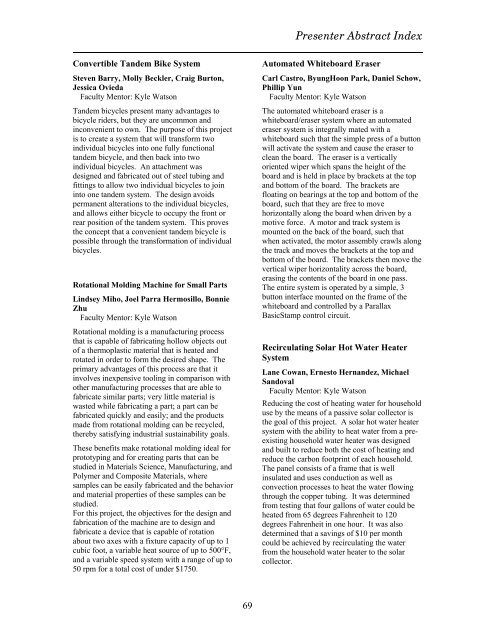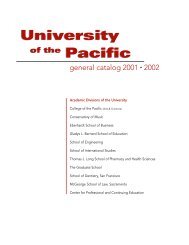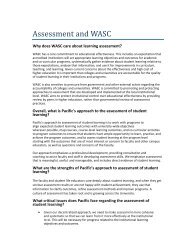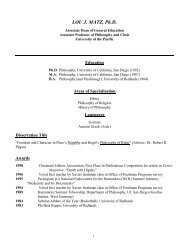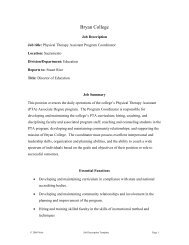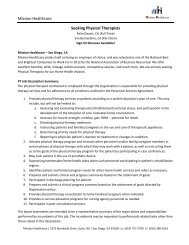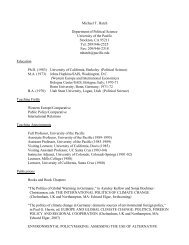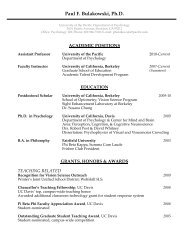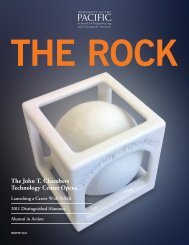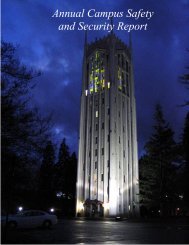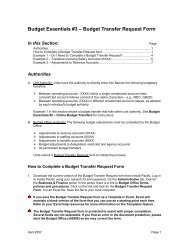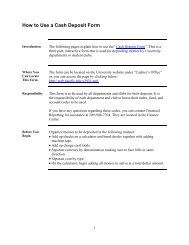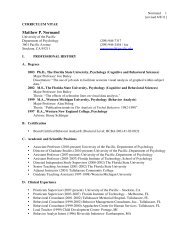purcc 2012 - University of the Pacific
purcc 2012 - University of the Pacific
purcc 2012 - University of the Pacific
Create successful ePaper yourself
Turn your PDF publications into a flip-book with our unique Google optimized e-Paper software.
Presenter Abstract Index<br />
Convertible Tandem Bike System<br />
Steven Barry, Molly Beckler, Craig Burton,<br />
Jessica Ovieda<br />
Faculty Mentor: Kyle Watson<br />
Tandem bicycles present many advantages to<br />
bicycle riders, but <strong>the</strong>y are uncommon and<br />
inconvenient to own. The purpose <strong>of</strong> this project<br />
is to create a system that will transform two<br />
individual bicycles into one fully functional<br />
tandem bicycle, and <strong>the</strong>n back into two<br />
individual bicycles. An attachment was<br />
designed and fabricated out <strong>of</strong> steel tubing and<br />
fittings to allow two individual bicycles to join<br />
into one tandem system. The design avoids<br />
permanent alterations to <strong>the</strong> individual bicycles,<br />
and allows ei<strong>the</strong>r bicycle to occupy <strong>the</strong> front or<br />
rear position <strong>of</strong> <strong>the</strong> tandem system. This proves<br />
<strong>the</strong> concept that a convenient tandem bicycle is<br />
possible through <strong>the</strong> transformation <strong>of</strong> individual<br />
bicycles.<br />
Rotational Molding Machine for Small Parts<br />
Lindsey Miho, Joel Parra Hermosillo, Bonnie<br />
Zhu<br />
Faculty Mentor: Kyle Watson<br />
Rotational molding is a manufacturing process<br />
that is capable <strong>of</strong> fabricating hollow objects out<br />
<strong>of</strong> a <strong>the</strong>rmoplastic material that is heated and<br />
rotated in order to form <strong>the</strong> desired shape. The<br />
primary advantages <strong>of</strong> this process are that it<br />
involves inexpensive tooling in comparison with<br />
o<strong>the</strong>r manufacturing processes that are able to<br />
fabricate similar parts; very little material is<br />
wasted while fabricating a part; a part can be<br />
fabricated quickly and easily; and <strong>the</strong> products<br />
made from rotational molding can be recycled,<br />
<strong>the</strong>reby satisfying industrial sustainability goals.<br />
These benefits make rotational molding ideal for<br />
prototyping and for creating parts that can be<br />
studied in Materials Science, Manufacturing, and<br />
Polymer and Composite Materials, where<br />
samples can be easily fabricated and <strong>the</strong> behavior<br />
and material properties <strong>of</strong> <strong>the</strong>se samples can be<br />
studied.<br />
For this project, <strong>the</strong> objectives for <strong>the</strong> design and<br />
fabrication <strong>of</strong> <strong>the</strong> machine are to design and<br />
fabricate a device that is capable <strong>of</strong> rotation<br />
about two axes with a fixture capacity <strong>of</strong> up to 1<br />
cubic foot, a variable heat source <strong>of</strong> up to 500°F,<br />
and a variable speed system with a range <strong>of</strong> up to<br />
50 rpm for a total cost <strong>of</strong> under $1750.<br />
Automated Whiteboard Eraser<br />
Carl Castro, ByungHoon Park, Daniel Schow,<br />
Phillip Yun<br />
Faculty Mentor: Kyle Watson<br />
The automated whiteboard eraser is a<br />
whiteboard/eraser system where an automated<br />
eraser system is integrally mated with a<br />
whiteboard such that <strong>the</strong> simple press <strong>of</strong> a button<br />
will activate <strong>the</strong> system and cause <strong>the</strong> eraser to<br />
clean <strong>the</strong> board. The eraser is a vertically<br />
oriented wiper which spans <strong>the</strong> height <strong>of</strong> <strong>the</strong><br />
board and is held in place by brackets at <strong>the</strong> top<br />
and bottom <strong>of</strong> <strong>the</strong> board. The brackets are<br />
floating on bearings at <strong>the</strong> top and bottom <strong>of</strong> <strong>the</strong><br />
board, such that <strong>the</strong>y are free to move<br />
horizontally along <strong>the</strong> board when driven by a<br />
motive force. A motor and track system is<br />
mounted on <strong>the</strong> back <strong>of</strong> <strong>the</strong> board, such that<br />
when activated, <strong>the</strong> motor assembly crawls along<br />
<strong>the</strong> track and moves <strong>the</strong> brackets at <strong>the</strong> top and<br />
bottom <strong>of</strong> <strong>the</strong> board. The brackets <strong>the</strong>n move <strong>the</strong><br />
vertical wiper horizontality across <strong>the</strong> board,<br />
erasing <strong>the</strong> contents <strong>of</strong> <strong>the</strong> board in one pass.<br />
The entire system is operated by a simple, 3<br />
button interface mounted on <strong>the</strong> frame <strong>of</strong> <strong>the</strong><br />
whiteboard and controlled by a Parallax<br />
BasicStamp control circuit.<br />
Recirculating Solar Hot Water Heater<br />
System<br />
Lane Cowan, Ernesto Hernandez, Michael<br />
Sandoval<br />
Faculty Mentor: Kyle Watson<br />
Reducing <strong>the</strong> cost <strong>of</strong> heating water for household<br />
use by <strong>the</strong> means <strong>of</strong> a passive solar collector is<br />
<strong>the</strong> goal <strong>of</strong> this project. A solar hot water heater<br />
system with <strong>the</strong> ability to heat water from a preexisting<br />
household water heater was designed<br />
and built to reduce both <strong>the</strong> cost <strong>of</strong> heating and<br />
reduce <strong>the</strong> carbon footprint <strong>of</strong> each household.<br />
The panel consists <strong>of</strong> a frame that is well<br />
insulated and uses conduction as well as<br />
convection processes to heat <strong>the</strong> water flowing<br />
through <strong>the</strong> copper tubing. It was determined<br />
from testing that four gallons <strong>of</strong> water could be<br />
heated from 65 degrees Fahrenheit to 120<br />
degrees Fahrenheit in one hour. It was also<br />
determined that a savings <strong>of</strong> $10 per month<br />
could be achieved by recirculating <strong>the</strong> water<br />
from <strong>the</strong> household water heater to <strong>the</strong> solar<br />
collector.<br />
69


